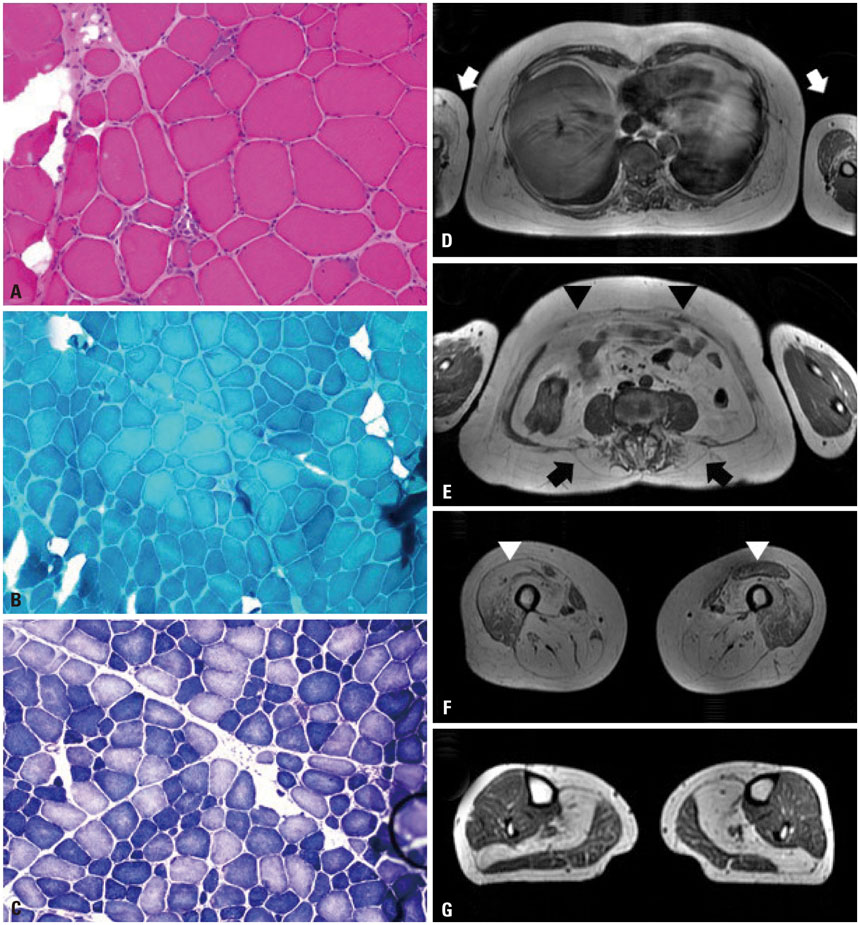Yonsei Med J.
2018 Mar;59(2):337-340. 10.3349/ymj.2018.59.2.337.
FAT1 Gene Alteration in Facioscapulohumeral Muscular Dystrophy Type 1
- Affiliations
-
- 1Department of Neurology, Gangneung Asan Hospital, University of Ulsan College of Medicine, Gangneung, Korea.
- 2Department of Chemistry, Yonsei University, Seoul, Korea.
- 3Department of Pathology, Yonsei University College of Medicine, Seoul, Korea.
- 4Department of Neurology, Yonsei University College of Medicine, Seoul, Korea. ycchoi@yuhs.ac
- 5Department of Neurology, Mokdong Hospital, Ewha Womans University School of Medicine, Seoul, Korea.
- 6Department of Clinical Pharmacology and Therapeutics, College of Medicine, Kyung Hee University, Seoul, Korea.
- KMID: 2418800
- DOI: http://doi.org/10.3349/ymj.2018.59.2.337
Abstract
- Facioscapulohumeral muscular dystrophy type 1 (FSHD1) is caused by contraction of the D4Z4 repeat array. Recent studies revealed that the FAT1 expression is associated with disease activity of FSHD, and the FAT1 alterations result in myopathy with a FSHD-like phenotype. We describe a 59-year-old woman with both contracted D4Z4 repeat units and a FAT1 mutation. Shoulder girdle muscle weakness developed at the age of 56 years, and was followed by proximal leg weakness. When we examined her at 59 years of age, she displayed asymmetric and predominant weakness of facial and proximal muscles. Muscle biopsy showed increased variation in fiber size and multifocal degenerating fibers with lymphocytic infiltration. Southern blot analysis revealed 8 D4Z4 repeat units, and targeted sequencing of modifier genes demonstrated the c.10331 A>G variant in the FAT1 gene. This FAT1 variant has previously been reported as pathogenic variant in a patient with FSHD-like phenotype. Our study is the first report of a FAT1 mutation in a FSHD1 patient, and suggests that FAT1 alterations might work as a genetic modifier.
MeSH Terms
Figure
Reference
-
1. Park HJ, Hong JM, Lee JH, Lee HS, Shin HY, Kim SM, et al. Low D4Z4 copy number and gender difference in Korean patients with facioscapulohumeral muscular dystrophy type 1. Neuromuscul Disord. 2015; 25:859–864.
Article2. Statland JM, Donlin-Smith CM, Tapscott SJ, Lemmers RJ, van der, Tawil R. Milder phenotype in facioscapulohumeral dystrophy with 7-10 residual D4Z4 repeats. Neurology. 2015; 85:2147–2150.
Article3. Scionti I, Fabbri G, Fiorillo C, Ricci G, Greco F, D’Amico R, et al. Facioscapulohumeral muscular dystrophy: new insights from compound heterozygotes and implication for prenatal genetic counselling. J Med Genet. 2012; 49:171–178.
Article4. Sacconi S, Lemmers RJ, Balog J, van der Vliet PJ, Lahaut P, van Nieuwenhuizen MP, et al. The FSHD2 gene SMCHD1 is a modifier of disease severity in families affected by FSHD1. Am J Hum Genet. 2013; 93:744–751.
Article5. van den Boogaard ML, Lemmers RJLF, Balog J, Wohlgemuth M, Auranen M, Mitsuhashi S, et al. Mutations in DNMT3B modify epigenetic repression of the D4Z4 repeat and the penetrance of facioscapulohumeral dystrophy. Am J Hum Genet. 2016; 98:1020–1029.
Article6. Caruso N, Herberth B, Bartoli M, Puppo F, Dumonceaux J, Zimmermann A, et al. Deregulation of the protocadherin gene FAT1 alters muscle shapes: implications for the pathogenesis of facioscapulohumeral dystrophy. PLoS Genet. 2013; 9:e1003550.
Article7. Mariot V, Roche S, Hourdé C, Portilho D, Sacconi S, Puppo F, et al. Correlation between low FAT1 expression and early affected muscle in facioscapulohumeral muscular dystrophy. Ann Neurol. 2015; 78:387–400.
Article8. Puppo F, Dionnet E, Gaillard MC, Gaildrat P, Castro C, Vovan C, et al. Identification of variants in the 4q35 gene FAT1 in patients with a facioscapulohumeral dystrophy-like phenotype. Hum Mutat. 2015; 36:443–453.
Article9. Hou R, Sibinga NE. Atrophin proteins interact with the Fat1 cadherin and regulate migration and orientation in vascular smooth muscle cells. J Biol Chem. 2009; 284:6955–6965.
Article10. Moeller MJ, Soofi A, Braun GS, Li X, Watzl C, Kriz W, et al. Protocadherin FAT1 binds Ena/VASP proteins and is necessary for actin dynamics and cell polarization. EMBO J. 2004; 23:3769–3779.
Article11. Cho E, Feng Y, Rauskolb C, Maitra S, Fehon R, Irvine KD. Delineation of a Fat tumor suppressor pathway. Nat Genet. 2006; 38:1142–1150.
Article12. Skouloudaki K, Puetz M, Simons M, Courbard JR, Boehlke C, Hartleben B, et al. Scribble participates in Hippo signaling and is required for normal zebrafish pronephros development. Proc Natl Acad Sci U S A. 2009; 106:8579–8584.
Article
- Full Text Links
- Actions
-
Cited
- CITED
-
- Close
- Share
- Similar articles
-
- Facioscapulohumeral muscular dystrophy: report of two cases
- Facioscapulohumeral Muscular Dystrophy Confirmedby D4Z4 Analysis
- Shoulder Motion after Scapulothoracic Arthrodesis of the Facioscapulohumeral Type of Progressive Muscular Dystrophy ( PMD )
- Application of Optical Genome Mapping to the Genetic Diagnosis of Facioscapulohumeral Muscular Dystrophy 1
- Extensive inflammatory reaction in facioscapulohumeral muscular dystrophy


